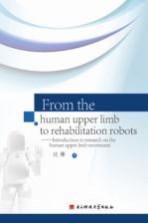
- 作 者:刘珊著
- 出 版 社:成都:电子科技大学出版社
- 出版年份:2010
- ISBN:7564704780
- 标注页数:127 页
- PDF页数:137 页
请阅读订购服务说明与试读!
订购服务说明
1、本站所有的书默认都是PDF格式,该格式图书只能阅读和打印,不能再次编辑。
2、除分上下册或者多册的情况下,一般PDF页数一定要大于标注页数才建议下单购买。【本资源137 ≥127页】
图书下载及付费说明
1、所有的电子图书为PDF格式,支持电脑、手机、平板等各类电子设备阅读;可以任意拷贝文件到不同的阅读设备里进行阅读。
2、电子图书在提交订单后一般半小时内处理完成,最晚48小时内处理完成。(非工作日购买会延迟)
3、所有的电子图书都是原书直接扫描方式制作而成。
Chapter 1 Introduction 1
1.1 The Motivation 1
1.2 The main problem and the main thesis 2
1.3 Organization of the book 4
Chapter 2 Human motor control 6
2.1 Introduction 6
2.2 The biological system 7
2.1.1 The central nervous system 7
2.2.2 Proprioceptors and the spinal cord 8
2.2.3 Motor neurons,and motor units 9
2.2.4 The muscle and the joints 10
2.2.5 Limitations of the technical description 10
2.3 Neuromotor control strategies 11
2.3.1 Feedback control 11
2.3.2 Feed-forward control 12
2.3.3 Adaptive control 13
2.3.4 Motor planning 14
2.3.5 Optimal control 15
2.3.6 Internal models 17
2.3.7 Artificial neural network control 18
2.4 Redundancy,degeneracy and parallelism 20
2.4.1 Multiple feedback loops 21
2.4.2 Spatial filtering 22
2.4.3 Learning to exploit the redundancy 23
2.5 Mathematical modeling 24
2.5.1 Theoretical muscle modeling 25
2.5.2 Modeling assumptions 25
2.5.3 Muscle contraction 26
2.5.4 Musculoskeletal system 27
2.5.5 Muscle model 28
2.5.6 Arm model 29
Chapter 3 Studying motor control 31
3.1 The inverse control problem 31
3.2 Forward model 33
3.3 Inverse model 35
3.4 Trajectory planning 35
3.5 Optimal control 36
3.6 Adaptive control 38
3.7 Hierarchical control 39
3.8 Neural network control 40
3.9 Reinforcement learning 42
3.10 Impedance control 43
3.11 End-effector control 45
Chapter 4 Motor learning and rehabilitation robot 47
4.1 Human-robot interaction 47
4.2 Motor learning 48
4.3 Current view of rehabilitation robot 49
4.4 Problem in current view 51
Chapter 5 Posture control of the upper limb 54
5.1 Posture control 54
5.2 Artificial neural network control 57
5.3 Multilayer perceptron network controller 59
5.3.1 Structure 59
5.3.2 Training algorithm 60
5.3.3 Simulation results 61
5.3.4 Discussion 63
5.4 Multivariable sliding-mode-based fuzzy CMAC 64
5.4.1 Problem formulation 64
5.4.2 Sliding-mode-based fuzzy CMAC 65
5.4.3 Training algorithm 66
5.4.4 Stability analysis 68
5.4.5 Simulation results 70
Chapter 6 Trajectory tracking control of the upper limb 72
6.1 Trajectory tracking control 72
6.2 Evolutionary diagonal recurrent neural network 73
6.2.1 Overview 73
6.2.2 Muscle model 74
6.2.3 Control system structure 74
6.2.4 Structure of the DRNN 75
6.2.5 Optimization of the DRNN Structure 75
6.2.6 DRNN Weight Training 78
6.2.7 Simulation Results 79
6.2.8 Discussion 85
6.3 Sliding-mode-based diagonal recurrent CMAC 85
6.3.1 Overview 85
6.3.2 Problem formulation 86
6.3.3 Sliding mode controller 86
6.3.4 SDRCMAC Architecture 87
6.3.5 Training algorithm 89
6.3.6 Stability analysis 91
6.3.7 Implementations and results 93
Chapter 7 Human-robot control system 96
7.1 Overview 96
7.2 Human-robot system 97
7.2.1 Structure 97
7.2.2 Function of patients'voluntary torque 97
7.2.3 Dynamic model 98
7.2.4 Control requirement 98
7.3 Sliding mode controller 99
7.3.1 Problem formulation 99
7.3.2 Controller design 100
7.3.3 Stability of the Control System 101
7.3.4 Simulation results 101
7.3.5 Summary and discussion 104
7.4 Robust control system 105
7.4.1 Controller architecture 105
7.4.2 Robust controller 105
7.4.3 Simulation results 106
7.4.4 Experimental results 108
7.4.5 Summary and discussion 114
7.5 SDRCMAC 115
Reference 117
